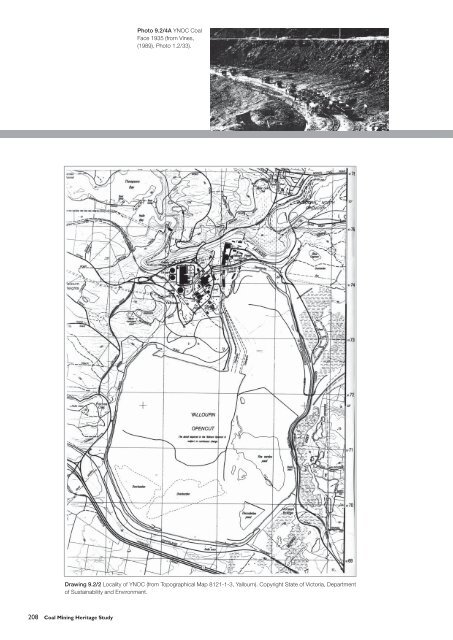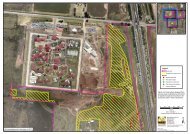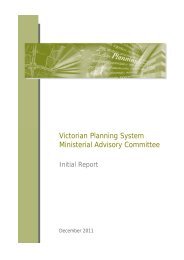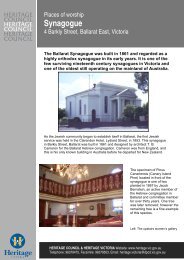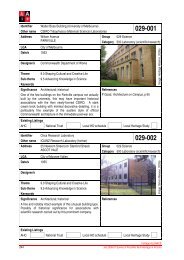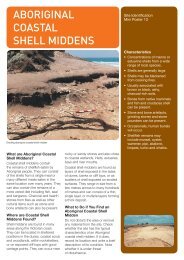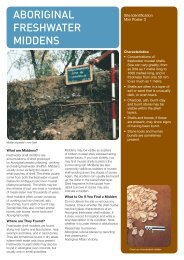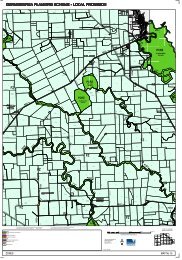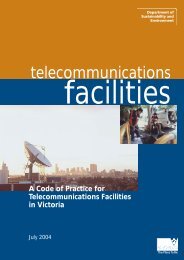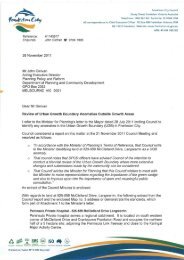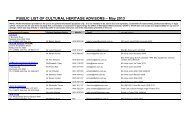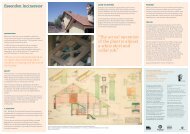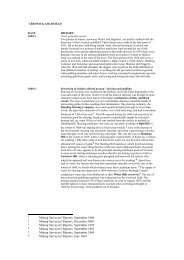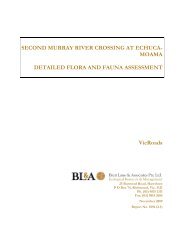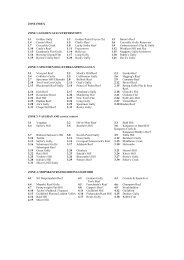pp 208-237 - Department of Planning and Community Development
pp 208-237 - Department of Planning and Community Development
pp 208-237 - Department of Planning and Community Development
Create successful ePaper yourself
Turn your PDF publications into a flip-book with our unique Google optimized e-Paper software.
Drawing 9.2/2 Locality <strong>of</strong> YNOC (from Topographical Map 8121-1-3, Yallourn). Copyright State <strong>of</strong> Victoria, <strong>Department</strong><br />
<strong>of</strong> Sustainability <strong>and</strong> Environment.<br />
<strong>208</strong> Coal Mining Heritage Study<br />
Photo 9.2/4A YNOC Coal<br />
Face 1935 (from Vines,<br />
(1989), Photo 1.2/33).
Photo 9.2/4B YNOC Coal Face 1941 (from Vines, (1994), Photo 1.31/3).<br />
Drawing 9.2/3 Number Five Bucket Wheel Dredger Plant Data (from Vines, (1989), Drawing 5.3/3).<br />
Photo 9.2/5A&B YNOC Open Cut Entrance <strong>and</strong> Overburden face<br />
1948 (from Vines, (1989), Photos 1.2/44 <strong>and</strong> 1.2/45).<br />
Coal Mining Heritage Study – Mine Sites Identifi cation 209
<strong>and</strong> tournapulls with scrapers <strong>and</strong> trailers (Photo 9.2/6).<br />
Overburden excavation was from two levels on the north face<br />
<strong>of</strong> the mine. In 1949, a second straightening <strong>of</strong> the Latrobe<br />
River was made to provide more space for overburden<br />
dumping. In August 1949, Euclid wagons were introduced<br />
for overburden haulage. In 1952, removal <strong>of</strong> overburden by<br />
contract was introduced on a new western development<br />
<strong>of</strong> the mine, taking over most <strong>of</strong> the overburden removal<br />
requirements. New annual overburden removal contracts<br />
were placed in most years through to 1960.<br />
At 1949, coal excavation was from several levels in the mine<br />
with face heights varying from 25 to 30 feet. Use <strong>of</strong> explosives<br />
to break up coal in the face was ab<strong>and</strong>oned with the cessation<br />
<strong>of</strong> h<strong>and</strong> excavation <strong>and</strong> replacement by machine excavation.<br />
From 1951, conveyor systems were progressively installed to<br />
give greater reliability <strong>of</strong> coal transportation in wet weather <strong>and</strong><br />
winter conditions, when road truck haulage on coal surfaces<br />
had proved unsatisfactory. Road haulage was retained for<br />
various smaller mining areas <strong>and</strong> also for transport during<br />
conveyor relocations <strong>and</strong> maintenance. Conveyors could be<br />
track-shifted to new locations on each level by a track-shifting<br />
head mounted on a tractor. A mobile crusher/loader was<br />
used with each coal excavator loading to a conveyor. A track<br />
mounted mobile truss conveyor with assembly options at 80,<br />
160, or 240 feet in length was available to extend the reach <strong>of</strong><br />
the excavators in special or developmental operations. 408<br />
In January 1953, a small electric-powered bucket wheel<br />
excavator with an output capacity <strong>of</strong> about 300 tons <strong>of</strong> coal<br />
per hour, originally intended for YOC but constructed at<br />
YNOC by the SECV, was brought into service. This machine<br />
was modifi ed for the harder coal at YNOC <strong>and</strong> did not require<br />
use <strong>of</strong> a crusher to achieve a small enough coal lump size<br />
for loading to conveyors. At 1956, four electric shovels <strong>and</strong> a<br />
dragline each <strong>of</strong> about 300 tons per hour capacity were also<br />
available at YNOC for overburden or coal excavation. 409 Table<br />
9.2/1 shows the annual outputs <strong>of</strong> the various excavators at<br />
YNOC from 1924 to 1963. 410<br />
A major batter slip occurred on the north face <strong>of</strong> YNOC after<br />
a period <strong>of</strong> heavy rain on 29 June 1950. Investigation <strong>of</strong> a<br />
cracked area at surface level <strong>and</strong> precautionary measures<br />
had been underway for about three weeks before the slip.<br />
‘An a<strong>pp</strong>roximate estimate <strong>of</strong> the volume <strong>of</strong> earth <strong>and</strong> coal<br />
involved in the movement is 300,000 cubic yards; the overall<br />
length <strong>of</strong> the slip is about 600 feet, the horizontal movement<br />
210 Coal Mining Heritage Study<br />
Photo 9.2/6 YNOC Electric Shovels<br />
excavating overburden 1948 (from<br />
Vines, (1989), Photo 1.2/49).<br />
Photo 9.2/7 YNOC Access Bridge<br />
1949 (from Vines, (1989),<br />
Photo 1.2/49).<br />
Photo 9.2/8A YNOC Number Five<br />
Dredger (from Vines, (1989),<br />
Photo 5.3/2).
Photo 9.2/8B YNOC Operating Plant<br />
circa 1960 (from Rusden, (1968)). Copyright<br />
TRUenergy.<br />
Photo 9.2/8C YNOC Coalfaces<br />
circa 1960 (from Rusden, (1968)). Copyright<br />
TRUenergy.<br />
Photo 9.2/8D YNOC VR loading<br />
arrangements circa 1960 (from Rusden,<br />
(1968)). Copyright TRUenergy.<br />
Photo 9.2/9 YNOC Yallourn North township<br />
at 1988 (from Vines, (1989), Photo 2/6).<br />
<strong>of</strong> the coal surface at about the centre <strong>of</strong> the slip was about<br />
210 feet, <strong>and</strong> the drop in level <strong>of</strong> the top <strong>of</strong> the sli<strong>pp</strong>ed<br />
coal was about 27 feet.’ 411 This slip area was trimmed <strong>and</strong><br />
consolidated at its toe but continued to experience minor<br />
movement over several years.<br />
By the early 1950s, the SECV, aware <strong>of</strong> the probable<br />
exhaustion <strong>of</strong> coal reserves at YNOC by the mid 1960s,<br />
initiated investigations on the optimum means <strong>of</strong> continuation<br />
<strong>of</strong> coal su<strong>pp</strong>ly to public buyers <strong>and</strong> in emergencies to SECV<br />
power stations <strong>and</strong> briquette factories. Although the Morwell<br />
Open Cut was also in progress by the early 1950s <strong>and</strong> could<br />
replace coal su<strong>pp</strong>lies from YNOC with various ineffi ciencies<br />
due mainly to higher moisture content <strong>of</strong> the MOC coal, the<br />
SECV gained Government a<strong>pp</strong>roval to open a further open<br />
cut on the same seam <strong>of</strong> coal as at YNOC at a location about<br />
three miles to the east <strong>of</strong> YNOC.<br />
‘The yearly output <strong>of</strong> coal from YNOC exceeded one million<br />
tons in each <strong>of</strong> the seven years from 1951/52 to 1957/58,<br />
with the peak output <strong>of</strong> over one <strong>and</strong> a half million tons in<br />
1955/56’. This latter year saw the commencement <strong>of</strong> coal<br />
winning from Yallourn North Extension Open Cut (YNEOC),<br />
which progressively took over the role <strong>and</strong> coal output <strong>of</strong><br />
Coal Mining Heritage Study – Mine Sites Identifi cation 211
Photo 9.2/10 YNOC Revegetation <strong>of</strong><br />
Western Pond circa 1973 (from Vines,<br />
(1989), Photo 2/3).<br />
Photo 9.2/11 YNOC Restoration <strong>of</strong><br />
overburden dumps at September 1973<br />
(from Vines, (1989), Photo 2/4).<br />
212 Coal Mining Heritage Study<br />
YNOC until the coal reserves at YNOC were worked out. Coal<br />
winning at YNOC terminated on 3 May 1963. 412 Overburden<br />
removal at YNOC ceased on 26 August 1960. 413<br />
As YNXOC took over from YNOC most <strong>of</strong> the excavating,<br />
conveying <strong>and</strong> mobile plant at YNOC was transferred<br />
progressively to the YNEOC. Until 1965, some coal deliveries<br />
continued from YNEOC to the outloading station at YNOC.<br />
For fi fteen years or so after the cessation <strong>of</strong> coal excavation<br />
at YNOC, extensive rehabilitation <strong>of</strong> the worked out batter<br />
systems with terracing <strong>of</strong> some batters <strong>and</strong> revegetation<br />
with commercial pine plantations was undertaken. Pondages<br />
were maintained in the east <strong>and</strong> west <strong>of</strong> the open cut, partly<br />
to achieve fi re protection <strong>and</strong> partly for aesthetic value. The<br />
central area in the open cut was used as a Yallourn Works<br />
Area hard rubbish dump. In the mid 1980s, a twin pondage<br />
arrangement was established in the central area <strong>of</strong> the YNOC<br />
to receive ash hydraulically from the Yallourn W Power Station.<br />
Each pond was operated alternatively for air drying <strong>of</strong> the ash<br />
before its excavation for disposal in the western area <strong>of</strong> the<br />
worked out open cut. This ash disposal activity was still in<br />
operation in 2005.<br />
Assessment <strong>of</strong> Heritage Signifi cance<br />
Historical Signifi cance<br />
The YNOC was operated as a public mining enterprise from<br />
1916 to 1963 <strong>and</strong> continued an operational activity thereafter as<br />
a public enterprise during restoration <strong>and</strong> ash disposal. It was a<br />
vital source <strong>of</strong> fuel su<strong>pp</strong>ly to power stations <strong>and</strong> other industries<br />
when their normal coal feedstock was in short su<strong>pp</strong>ly.<br />
The YNOC was the initial source <strong>of</strong> fuel su<strong>pp</strong>ly for the Yallourn<br />
Power Station when it was found that the Yallourn Open Cut<br />
coal had higher moisture content than expected, <strong>and</strong> that the<br />
power production plant under construction required extensive<br />
modifi cation to contend with the Yallourn Seam coal. It was<br />
not until 1928, four years later than expected, that the Yallourn<br />
Power Station became independent <strong>of</strong> coal su<strong>pp</strong>ly from YNOC.<br />
It would have been a disastrous power su<strong>pp</strong>ly situation for<br />
Victoria if the YNOC coal had not been available as a reliable
su<strong>pp</strong>ly in suffi cient quantity to meet the initial dem<strong>and</strong>, <strong>and</strong><br />
subsequently to blend with Yallourn seam coal as the Power<br />
Station modifi cations achieved their objectives.<br />
Scientifi c Signifi cance<br />
A signifi cant amount <strong>of</strong> analytic <strong>and</strong> combustion testing was<br />
carried out on the YNOC coal source prior to the a<strong>pp</strong>roval<br />
by Government that the essential major post World War One<br />
electricity generation project would be via a State Authority,<br />
<strong>and</strong> be based on the brown coal resources <strong>of</strong> the State.<br />
Economic Signifi cance<br />
From the 1920s to the 1960s, coal output from the YNOC<br />
was the source <strong>of</strong> energy su<strong>pp</strong>ly to many small industrial<br />
plants in the metropolitan area, as well as more scattered<br />
plants including country hospitals <strong>and</strong> the Maryvale<br />
Paper Mill.<br />
Photo 9.2/12 YNOC Ash pond<br />
lining at 1987 (from Vines, (1989),<br />
Photo 3/1).<br />
Photo 9.2/13 YNOC Ash<br />
discharge into pondages at 1987<br />
(from Vines, (1989, Photo 3/2).<br />
Photo 9.2/14 YNOC 1993<br />
Panorama (from Vines, (1994),<br />
Photo 1.31/5).<br />
From 1941, at Government direction, mechanisation <strong>of</strong> the<br />
mining process at YNOC provided a strategic reserve <strong>of</strong> coal<br />
ready for immediate increase in output <strong>and</strong> suitable for use in<br />
power stations to replace or su<strong>pp</strong>lement other fuels. Through<br />
the 1950s, when its coal output exceeded one million tons<br />
annually for several years, it was a prime source <strong>of</strong> energy to<br />
the established power stations as newer stations had been<br />
delayed by fi nancial restrictions <strong>and</strong> constraints.<br />
Social Signifi cance<br />
The township immediately adjacent to the YNOC emerged<br />
from a tent town <strong>of</strong> the late 1910s. For the fi rst 40 years or<br />
so <strong>of</strong> its existence, it was a dormitory town consisting <strong>of</strong> low<br />
cost housing with a large proportion <strong>of</strong> residents deriving their<br />
incomes as employees <strong>of</strong> the adjacent mine <strong>and</strong> subsequently<br />
<strong>of</strong> the Yallourn Works complex. The name <strong>of</strong> the township<br />
changed from ‘the Brown Coal Mine’, to the ‘Old Brown Coal<br />
Mine’ <strong>and</strong> by the 1940s to ‘Yallourn North’.<br />
Many <strong>of</strong> the early mine employees were <strong>of</strong> Maltese origin.<br />
As British English-speaking citizens, sponsorship by relatives<br />
in Australia overcame barriers to migration. From the mid-<br />
1930s, signifi cant numbers <strong>of</strong> new employees for the Yallourn<br />
Works complex, mainly from the unemployed workforce <strong>of</strong> the<br />
1930s Depression, were housed in an SECV camp at Yallourn<br />
North. By the early 1950s, a large number <strong>of</strong> public authority<br />
houses were erected at Yallourn North to provide housing for<br />
a large migrant intake. The advantage <strong>of</strong> this site was that<br />
employees at the Yallourn North Open Cut <strong>and</strong> the Yallourn<br />
Works area could walk to work. For many <strong>of</strong> these migrants<br />
this was their fi rst home <strong>and</strong> fi rst workplace in Australia. The<br />
township remains a closely knit dormitory township mainly for<br />
the employees <strong>of</strong> the mining <strong>and</strong> power generation companies<br />
in the Latrobe Valley. Former migrant employees at the YNOC<br />
formed the core <strong>of</strong> this township population, <strong>and</strong> many second<br />
<strong>and</strong> third generation employees <strong>of</strong> the mining <strong>and</strong> power<br />
industry in the Latrobe Valley trace their work <strong>and</strong> housing<br />
origins to the YNOC <strong>and</strong> its township. The success story<br />
<strong>of</strong> multiculturalism at the Yallourn North township preceded<br />
that <strong>of</strong> the Snowy Mountains townships. The Yallourn North<br />
Township originating from the workforce needs <strong>of</strong> the YNOC<br />
remains a vibrant community to this day.<br />
Coal Mining Heritage Study – Mine Sites Identifi cation 213
Mine Infrastructure Features<br />
Rehabilitation <strong>of</strong> the mine site.<br />
The YNOC bridge – the fourth at this site.<br />
The mine entry.<br />
The remaining foundations <strong>of</strong> the YNOC power station.<br />
The area <strong>of</strong> the major batter slip <strong>of</strong> 1950.<br />
References<br />
McKay, RJ, History <strong>of</strong> the <strong>Development</strong> <strong>of</strong> the Brown Coal<br />
Open Cut Workings at Yallourn, SECV, 1950<br />
Rusden, GF, History <strong>of</strong> Yallourn, Yallourn North, <strong>and</strong> Yallourn<br />
North Extension Open Cuts, July 1947 to June 1965, SECV,<br />
1968<br />
Annual Report, SECV, 1925, p. 27<br />
Three Decades: The Story <strong>of</strong> the State Electricity Commission<br />
<strong>of</strong> Victoria from its inception to December 1948, SECV, 1949,<br />
<strong>pp</strong>.44–46<br />
Vines, JA, A Technical History <strong>of</strong> Yallourn North <strong>and</strong> Yallourn<br />
North Extension Open Cuts 1965–1988, SECV, 1989<br />
214 Coal Mining Heritage Study<br />
9.3 Yallourn Open Cut<br />
Map Reference: 8121-1-3 Yallourn Zone 55<br />
Municipality: City <strong>of</strong> Latrobe<br />
Open Cut entrance 4430, 57740<br />
East Field entrance 4442, 57737<br />
L<strong>and</strong> Use/Status: Private since 1996<br />
Site History<br />
In the 1880s <strong>and</strong> early 1890s, with the discovery <strong>and</strong><br />
development <strong>of</strong> the brown coal deposit called the Great<br />
Morwell Brown Coal Mine, mining leases were taken out by<br />
various private individuals <strong>and</strong> syndicates on about 30 square<br />
miles <strong>of</strong> the l<strong>and</strong> south <strong>of</strong> the Latrobe River <strong>and</strong> east-west<br />
between Morwell to the Haunted Hills at the east <strong>of</strong> Moe.<br />
This area had been proven to contain thick brown coal<br />
deposits close to ground surface, <strong>and</strong> had been traversed<br />
by the main Gi<strong>pp</strong>sl<strong>and</strong> Railway from 1878.<br />
Diffi culties experienced by the Great Morwell Coal Mine<br />
Company in marketing its product in Victoria, in competition<br />
against entrenched black coal su<strong>pp</strong>lies, suspended<br />
development <strong>of</strong> several other brown coal mining ventures<br />
by 1900.<br />
However the potential <strong>of</strong> the extensive deposit in the wider<br />
Latrobe Valley had been recognised by Government, resulting<br />
in the establishment <strong>of</strong> a Royal Commission (1889–1891).<br />
Recommendations from this Commission prompted Government<br />
to sponsor <strong>and</strong> undertake increased testing <strong>and</strong> research into<br />
the extent, properties, <strong>and</strong> potential utilisation <strong>of</strong> this low grade<br />
coal. The Royal Commission also recommended a greater role<br />
for Government in the control <strong>and</strong> development <strong>of</strong> the resource.<br />
In 1909, the Government established the State Coal Mine on<br />
the Powlett River black coal seams in south west Gi<strong>pp</strong>sl<strong>and</strong><br />
to provide an alternative or su<strong>pp</strong>lementary black coal su<strong>pp</strong>ly<br />
to the Newport Power Station, operated by the Railways<br />
Commissioners.<br />
In 1912, a report by C Merz commissioned by Government<br />
recommended, among other projects, a base load power
Photo 9.3/1 YOC early activities (from Vines, (1994), p. 5).<br />
Coal Mining Heritage Study – Mine Sites Identifi cation 215
station on the brown coal deposits near Morwell to provide<br />
for the expected electricity growth throughout the State.<br />
Government action on this recommendation was deferred<br />
while other options, such as a private development <strong>of</strong> the<br />
Altona brown coal deposit <strong>and</strong>/or hydro power from the<br />
Kiewa <strong>and</strong> other rivers, were given further consideration. In<br />
September 1917, a Brown Coal Advisory Committee with<br />
H.Herman as Chairman a<strong>pp</strong>ointed by Government, strongly<br />
recommended the Morwell project. 414<br />
In late 1918, the Minister for Public Works requested Lindsay<br />
Clark, a consultant mining engineer, to report on suitable<br />
methods <strong>of</strong> mining <strong>and</strong> resultant costs <strong>of</strong> development in a<br />
specifi cally nominated one square mile area on the south <strong>of</strong><br />
the Latrobe River o<strong>pp</strong>osite the entrance to the Great Morwell<br />
Mine. Lindesay Clark visited this site over a two day period.<br />
In a letter to the Minister dated 6 December 1918, Clark<br />
acknowledged the drilling <strong>and</strong> geological information su<strong>pp</strong>lied<br />
to him by Mines <strong>Department</strong> staff <strong>and</strong> proposed a mining<br />
scheme <strong>and</strong> costs <strong>of</strong> development <strong>of</strong> the mine. 415<br />
In January 1919, the Government a<strong>pp</strong>ointed three Electricity<br />
Commissioners with duties including ‘the preparation <strong>of</strong><br />
a scheme <strong>of</strong> coal mining <strong>and</strong> electric su<strong>pp</strong>ly at Morwell’.<br />
In November 1919, the Commissioners submitted their<br />
report recommending a State owned power <strong>and</strong> briquetting<br />
development at Morwell including the mining proposal as<br />
prepared by Lindsay Clark. The Government authorised the<br />
Morwell project (to be known as the Yallourn Project from<br />
1920) in December 1919. The Commissioners recruited<br />
key staff to prepare detailed proposals. From September<br />
1920 the Commissioners called tenders for power plant,<br />
transmission lines <strong>and</strong> open cut equipment. Under a new act,<br />
the State Electricity Commission <strong>of</strong> Victoria was established<br />
to commence this project within a wide range <strong>of</strong> other powers<br />
for the management <strong>of</strong> electricity su<strong>pp</strong>ly throughout the<br />
State. 416 Sir John Monash was a<strong>pp</strong>ointed the fi rst Chairman<br />
<strong>of</strong> the SECV, as from 1 January 1921. He had previously been<br />
a<strong>pp</strong>ointed on 1 October 1920 as General Manager under<br />
the Electricity Commissioners with the underst<strong>and</strong>ing that<br />
he would be a<strong>pp</strong>ointed chairman as soon as the necessary<br />
legislation could be enacted. Lindesay Clark was a<strong>pp</strong>ointed<br />
by the Commissioners on 28 May 1920 as Consulting<br />
Engineer for Coal Winning. The mining plan by Lindesay Clark<br />
was a<strong>pp</strong>roved by the Commissioners on 1 October 1920,<br />
the same day as their a<strong>pp</strong>ointment <strong>of</strong> Monash as<br />
General Manager.<br />
216 Coal Mining Heritage Study<br />
Photo 9.3/2 YOC First Dredger<br />
Number <strong>208</strong>. Ladder dredger<br />
excavating overburden to rail tracks<br />
(from SECV Three Decades, 1949,<br />
p. 39). Copyright State Electricity<br />
Commission <strong>of</strong> Victoria.<br />
Photo 9.3/3 YOC <strong>Development</strong><br />
at 1931: Nos 1 <strong>and</strong> 2 Ladder<br />
Dredgers on coal faces (from<br />
SECV Three Decades, 1949,<br />
p. 41). Copyright State Electricity<br />
Commission <strong>of</strong> Victoria.<br />
The mine plan was based on American/Australian mining<br />
plant as being the only excavation plant available, Germany<br />
not having restored manufacturing at this time <strong>of</strong> post-war<br />
recovery.<br />
Mining commenced in October 1920 using horse drawn<br />
scoops to build protective levee banks. In October 1920, an<br />
order was placed for two mechanical shovels <strong>of</strong> two <strong>and</strong> a<br />
half <strong>and</strong> three <strong>and</strong> a half bucket capacity respectively. A small<br />
steam shovel commenced in February 1921 with output <strong>of</strong><br />
about 450 cubic yards per day. In February 1921, orders<br />
were placed for overburden conveying <strong>and</strong> stacking plant<br />
<strong>and</strong> tenders called for endless ropeway haulage systems for<br />
coal transport. In May 1921, arrangements were made with<br />
Victorian Railways for rail access <strong>and</strong> provision <strong>of</strong> sidings. 417<br />
Later this rail connection was extended to YNOC.<br />
Horse-drawn three cubic yard side ti<strong>pp</strong>ing trucks were used<br />
initially on overburden transport until a conveyor/stacker<br />
system came into service in May 1922. In November 1922,
Photo 9.3/4 YOC Number 4<br />
Ladder Dredger (from Rodgers).<br />
Copyright State Electricity<br />
Commission <strong>of</strong> Victoria.<br />
Drawing 9.3/1 YOC Initial Calculation by L Clark <strong>of</strong> overburden in designated area, August 1919.<br />
work commenced on a ‘deep drainage scheme’ via shafts <strong>and</strong><br />
tunnels in attempts to lower the moisture content in the coal<br />
before excavation. After several years <strong>of</strong> pumping, this scheme<br />
was ab<strong>and</strong>oned as being ineffective <strong>and</strong> not cost justifi ed.<br />
Coal deliveries to the Yallourn power station commenced<br />
on 21 August 1924 <strong>and</strong> to the briquette factory in October<br />
1924. Until 1927, coal from YNOC was also used in Yallourn<br />
Power Station, these deliveries progressively decreasing as<br />
combustion problems with the high moisture YOC coal were<br />
successfully contended with.<br />
In 1924, mobile crusher/loaders were introduced to load<br />
crushed coal to the six cubic yard capacity rope haulage coal<br />
trucks. In January 1925, a three foot six inch gauge rail system<br />
was installed on the coal benches for use with steam locos<br />
Coal Mining Heritage Study – Mine Sites Identifi cation 217
<strong>and</strong> fi ve cubic yard side ti<strong>pp</strong>ing trucks. Drawing 9.3/3 shows<br />
the layout <strong>of</strong> the YOC in February 1925. In June 1925, a larger<br />
shovel with a ten cubic yard bucket came into service. A two<br />
cubic yard dragline, three steam locomotives <strong>and</strong> 40 fi ve cubic<br />
yard trucks came into service up to July 1926.<br />
218 Coal Mining Heritage Study<br />
Photo 9.3/5A YOC Numbers<br />
One <strong>and</strong> Two Overburden<br />
Spreaders (from Vines, (1994),<br />
p. 67).<br />
Drawing 9.3/2 YOC Depiction <strong>of</strong> coal resource for ‘Morwell Project’ by H Herman, November 1919.<br />
In December 1925, taking into consideration longer term plans<br />
to increase electricity generation from a proposed expansion<br />
<strong>of</strong> Yallourn Power Station, the SECV decided ‘to ab<strong>and</strong>on the<br />
original methods <strong>of</strong> open cut operation <strong>and</strong> to introduce plant<br />
<strong>and</strong> methods which had proved successful in German brown
coal open cut workings’. 418 The role <strong>of</strong> Lindesay Clark as<br />
consultant mining engineer had been terminated in June 1924.<br />
Advice on the changeover to German procedures <strong>and</strong> plant<br />
was now provided to the SECV Board by visitation <strong>of</strong> staff to<br />
Germany <strong>and</strong> visitation <strong>of</strong> German experts to Victoria. 419<br />
A 90 centimetre 1100 Volt DC electric rail system was<br />
progressively installed for transport <strong>of</strong> coal <strong>and</strong> overburden,<br />
replacing the rope haulages <strong>and</strong> the steam loco rail system.<br />
This 90 centimetre rail system came into service on coal<br />
transport in September 1927 <strong>and</strong> on overburden transport<br />
in February 1928. An electric powered single portal revolving<br />
bucket dredge (Dredger <strong>208</strong>) also came into service on<br />
overburden excavation in February 1928. Overburden was<br />
out-loaded from the 90 centimetre rail system to a movable<br />
track ho<strong>pp</strong>er loading a movable conveyor discharging to the<br />
Boomstacker, the fi rst overburden spreader in YOC. Dumping<br />
<strong>of</strong> overburden was also available via a 90 centimetre rail<br />
electric dump plough. 420<br />
Two rail mounted Dredgers (SECV Dredgers Number One<br />
<strong>and</strong> Number Two) came into service on coal excavation, the<br />
Photo 9.3/5B YOC Numbers One<br />
<strong>and</strong> Two Overburden Spreaders<br />
(from Vines, (1994), p. 67).<br />
Drawing 9.3/3 YOC at 1925 as developed to plans by L Clark (from McKay, (1950), Plan Number Two).<br />
fi rst in July 1929 <strong>and</strong> the second in March 1931. A fl eet <strong>of</strong><br />
eighty 20 tonne gable bottom coal trucks was progressively<br />
introduced as coal dem<strong>and</strong> grew from 1927 through to<br />
1951. 421 The capacity <strong>of</strong> coal haulage was increased in<br />
1954–58 by the addition <strong>of</strong> ninety two 33 ton capacity gable<br />
bottom coal trucks <strong>and</strong> in 1961–64 by the conversion <strong>of</strong> 85 <strong>of</strong><br />
the early coal <strong>and</strong> overburden trucks to 26 ton gable bottom<br />
coal trucks. Coal output from the fi rst two coal dredgers was<br />
su<strong>pp</strong>lemented from six different shovels until bucket wheel<br />
dredgers were introduced post-World War Two: Number 3<br />
Dredger in October 1950, Number 6 Dredger in May 1956 <strong>and</strong><br />
Number 7 Dredger in October 1956. Transport <strong>of</strong> YOC coal to<br />
the Yallourn Briquette factory converted from rope haulage to<br />
conveyors progressively through 1942–1947. 422<br />
In 1940, dumping <strong>of</strong> overburden into the base <strong>of</strong> YOC<br />
commenced by dragline <strong>and</strong> dump plough. Number One<br />
Spreader, converted from the early Boomstacker, came<br />
into service in 1943 <strong>and</strong> Number Two Spreader in 1953. In<br />
1951, Number Four dredger, a bucket chain dredger, came<br />
into service to replace Number <strong>208</strong> dredger on Overburden<br />
Coal Mining Heritage Study – Mine Sites Identifi cation 219
Photo 9.3/6 YOC/MOC Loco<br />
on ICR Bridge over Morwell<br />
River (from Vines, (1994), p.175).<br />
Photo 9.3/7 YOC Numbers 6<br />
<strong>and</strong> 8 Dredgers on coalfaces<br />
(from Vines, (1989), p.107).<br />
Drawing 9.3/4 YOC at 1947 (from Herman, (1952), Fig.180).<br />
220 Coal Mining Heritage Study
emoval. 423 Seventy 32 cubic yard side ti<strong>pp</strong>ing overburden<br />
trucks were introduced between 1952–54 to replace ninety<br />
20 cubic yard side ti<strong>pp</strong>ing trucks purchased from 1927.<br />
The electric locomotive fl eet comprised 24 46-ton locos<br />
(1927–1953), 13 60-ton locos (1950–1954) <strong>and</strong> fi ve 62-ton<br />
locos (1963–1967). 424<br />
By 1956, annual coal output from YOC had reached eight<br />
million tons with deliveries <strong>of</strong> coal from Morwell Open Cut<br />
to YPS commencing as the new open cut excavated its<br />
fi rst coal to open up a coalface to prepare for su<strong>pp</strong>ly to the<br />
Photo 9.3/8 YOC Number 8<br />
Dredger on coalface (from Vines,<br />
(1989), p.104).<br />
Drawing 9.3/5 YOC Proposed development from 1955 into the South Field (from Stewart,<br />
(1960), p. 45).<br />
Morwell Power Station, then under construction. 425 In 1956,<br />
an interconnecting SECV rail line <strong>of</strong> 90 centimetre gauge<br />
came into service between the two open cuts, initially with<br />
the purpose <strong>of</strong> disposing <strong>of</strong> the early overburden output from<br />
Morwell into the base <strong>of</strong> the Yallourn Open Cut but with the<br />
longer term objective <strong>of</strong> achieving greater reliability <strong>of</strong> coal<br />
su<strong>pp</strong>lies being available from both open cuts. 426<br />
Additional excavators, all <strong>of</strong> German design to detailed<br />
specifi cation by the SECV, were brought into service to meet<br />
increasing coal dem<strong>and</strong> from additional units at Yallourn Power<br />
Coal Mining Heritage Study – Mine Sites Identifi cation 221
Photo 9.3/9 YOC views 1962/63<br />
(from Vines, (1989), p.112).<br />
Photo 9.3/10 YOC Open Cut<br />
<strong>and</strong> Yallourn township, 1973<br />
(from Vines, (1994), p.131).<br />
Station – Number Eight bucket chain Dredger in 1960, 427,428<br />
Number 12 bucket wheel Dredger in 1974, Number 13 bucket<br />
wheel Dredger in 1977, Number 24 compact bucket wheel<br />
Dredger in 1984. Numbers One, Two <strong>and</strong> Four dredgers were<br />
retired between 1970 <strong>and</strong> 1974. Number Three Dredger was<br />
transferred to Morwell Open Cut from 1959 to 1983 <strong>and</strong> was<br />
retired in 1984 after retransfer to YOC. Number 24 Dredger<br />
was transferred to Morwell Open Cut in June 1987. The coal<br />
rail haulage systems were progressively phased out from 1974,<br />
with all replaced by higher capacity conveyor systems by<br />
1984. Train systems on overburden excavation <strong>and</strong> disposal<br />
operations had been converted to conveyors in 1962/63. 429<br />
Coal output from YOC peaked at 22.275 million tonnes in<br />
the 1981–82 year. 430 From 1960, YOC coal deliveries to the<br />
Morwell Briquette Factory had averaged over three million tons<br />
per year.<br />
Yallourn Open Cut had exp<strong>and</strong>ed its operational area via a<br />
series <strong>of</strong> pivot points in a clockwise rotation from the early<br />
1920s 431 until excavating through the former Yallourn Township<br />
222 Coal Mining Heritage Study<br />
area from 1981. On 1 May 1992, overburden excavation in<br />
the East Field commenced with Dredger Number 13 loading<br />
conveyors. A diversion <strong>of</strong> the Morwell River <strong>and</strong> <strong>of</strong> the<br />
Interconnecting Railway had been undertaken to gain access<br />
to the coal reserves in the East Field. 432<br />
On 8 April 1982, the Labour Party came to Government after<br />
34 years as the o<strong>pp</strong>osition party <strong>and</strong> continued in Government<br />
until replaced by a Liberal-National Party Coalition Government<br />
in October 1992. The SECV was disaggregated in January<br />
1994, with Generation Victoria allocated management <strong>of</strong> the<br />
coal mines, power stations <strong>and</strong> associated activities. On<br />
1 April 1996, the former SECV coal mining assets <strong>and</strong> activities<br />
at Yallourn were privatised via sale to Yallourn Energy. At 2005,<br />
this company remained in this role with one shareholder, China<br />
Light <strong>and</strong> Power (CLP).<br />
In September 1993, transport <strong>of</strong> briquetting coal from YOC<br />
to MOC on the Interconnecting Railway was contracted<br />
to a private contractor who used diesel locos <strong>and</strong> ex-SEC<br />
coal trucks on the ICR, eliminating the 1100 volt DC traction
Photo 9.3/11 Yallourn Power<br />
Station showing coal delivery<br />
system circa 1962 (from Vines,<br />
(1994), p.133).<br />
Drawing 9.3/6 YOC Excavators allocated for overburden removal, 1922 to post-1977 (from Vines, (1989), p. 84, as copied<br />
from Rodgers (1960)).<br />
Drawing 9.3/7 YOC proposal as adopted for extension into the East Field, 1981 (from Vines, (1989), p. 203).<br />
Coal Mining Heritage Study – Mine Sites Identifi cation 223
Photo 9.3/12 Yallourn town<br />
centre, 1973. Copyright State<br />
Electricity Commission <strong>of</strong><br />
Victoria.<br />
Photo 9.3/13 Yallourn township<br />
view, 1975 (from Vines, (1994)<br />
p.151). Copyright State<br />
Electricity Commission <strong>of</strong><br />
Victoria.<br />
Drawing 9.3/8 YOC conveyor systems <strong>and</strong> disposition <strong>of</strong> excavators to East Field from 1987 (from Vines, (1989), p. 94).<br />
system. The annual usage <strong>of</strong> briquetting coal had fallen to<br />
1.264 million tonnes by 1992/93, before this contract was<br />
placed. In August 1994, the Interconnecting Railway <strong>and</strong> its<br />
loading points, marshalling yards <strong>and</strong> conveyors to the Morwell<br />
Briquette Factory raw coal bunker were sold to Energy Brix, a<br />
private company which had bought the Morwell Briquette <strong>and</strong><br />
Power Station assets. 433<br />
In February 2002, major earthworks for a Morwell River diversion<br />
3.5 kilometres long <strong>and</strong> up to 140 metres wide from levee<br />
top to top, commenced by contract ‘with nine 85 tonne <strong>and</strong><br />
thirteen 50 tonne dump trucks <strong>and</strong> three excavators excavating<br />
26,000 cubic metres per day <strong>of</strong> earth’ from the eastern end <strong>of</strong><br />
the East Field. 434 The Morwell River confl uence with the Latrobe<br />
River was relocated about four kilometres upstream from its<br />
previous location in the Latrobe River. 435 This river diversion<br />
to the western side <strong>of</strong> the East Field ‘allowed substantial new<br />
224 Coal Mining Heritage Study<br />
coal reserves to be accessed [in the East <strong>and</strong> Maryvale Fields],<br />
extending the mine’s life by about 25 years to 2032’. 436 Water<br />
fl ow through these river diversion works took place on 27 May<br />
2005. In 2004, four tunnels for overburden <strong>and</strong> coal transport<br />
under the river diversion had been completed <strong>and</strong> h<strong>and</strong>ed over<br />
for installation <strong>of</strong> conveyors.<br />
In February 2002, trials were proceeding for utilisation <strong>of</strong> a<br />
120 tonne D11R bulldozer loading coal down a decline into<br />
a feeder-breaker for delivery to a coal face conveyor. The<br />
tests were considered successful <strong>and</strong> intended to avoid<br />
high expenditure on maintenance or replacement <strong>of</strong> ageing<br />
dredgers for the coal excavation in the prolonged east fi eld<br />
extension <strong>and</strong> the Maryvale Field. 437<br />
At January 2003, it was expected that all coal mining in the<br />
YOC would be converted to slope mining by June 2003.
Photo 9.3/14 Electric loco being out-loaded to the Railways Museum<br />
at North Williamstown, 1985 (from Vines, (1994), p.151).<br />
The slope mining operation was in progress by contract to<br />
Yallourn Energy with the dozing plant anticipated to have a<br />
fi ve year operating life. 438 Two or possibly three slope mining<br />
systems were expected to meet coal dem<strong>and</strong> from Yallourn<br />
W Power Station. Briquetting coal su<strong>pp</strong>lies from YOC to the<br />
Morwell Briquette Works had ceased with su<strong>pp</strong>ly transferred<br />
to Loy Yang Open Cut. This cessation eliminated the practice<br />
in YOC <strong>of</strong> identifying, selecting, storing <strong>and</strong> delivering coal for<br />
briquetting as s<strong>and</strong> free, <strong>of</strong> light lithotype <strong>and</strong> with low woody<br />
or fi brous content. This cessation permitted the slope mining<br />
operation to produce ‘run-<strong>of</strong>-mine’ excavation albeit with<br />
selective storage areas in the raw coal bunker.<br />
At 2003, Dredgers Number Six <strong>and</strong> Number Seven, each<br />
with over 45 years <strong>of</strong> operation, were retired <strong>and</strong> made<br />
available for sale or demolition. Dredger Number Eight with<br />
over 40 years <strong>of</strong> operation was parked <strong>and</strong> not being used.<br />
Dredger Number 12 was on st<strong>and</strong>by available to take over<br />
from Dredger Number 13 on overburden removal or to be<br />
used for development or emergency operation on coal<br />
winning. Annual coal dem<strong>and</strong> <strong>of</strong> about 17.5 million tonnes<br />
was being met with over 99.9 per cent reliability.<br />
Photo 9.3/15 YOC Air photo 1992, including the East Field (from<br />
Vines, (1994), p.181).<br />
Thus, at 2005, Yallourn Open Cut had been in continuous<br />
operation for 83 years, now su<strong>pp</strong>lying coal exclusively to<br />
Yallourn W Power station which was generating about 22 per<br />
cent <strong>of</strong> Victoria’s electricity consumption. As from 1 July 2005<br />
the owners <strong>of</strong> Yallourn Energy changed its name to TRU Energy<br />
in a consolidation with its other energy interests in Australia.<br />
Assessment <strong>of</strong> Heritage Signifi cance<br />
Historical Signifi cance<br />
The Yallourn Open Cut was the fi rst large-scale project to<br />
attain effective commercial utilisation <strong>of</strong> the vast brown coal<br />
energy resource <strong>of</strong> the Latrobe Valley.<br />
The success <strong>of</strong> the Yallourn Power Station <strong>and</strong> Briquette<br />
Works fuelled from YOC led to further utilisation <strong>of</strong> the brown<br />
coal resource in power stations, gas manufacture, briquettes,<br />
hard char, pulverised fuel <strong>and</strong> conversion to liquid fuels.<br />
Coal Mining Heritage Study – Mine Sites Identifi cation 225
Drawing 9.3/9 YOC annual coal output, 1924 to 1993 (from Vines,<br />
(1994), p.143).<br />
Scientifi c Signifi cance<br />
The techniques <strong>of</strong> combusting the friable high moisture<br />
coal from YOC were developed under extreme public <strong>and</strong><br />
government criticism as the initial drying <strong>and</strong> boiler plant<br />
required modifi cation <strong>and</strong> su<strong>pp</strong>lementation. Post World War<br />
One access to the a<strong>pp</strong>lied scientifi c experience in the German<br />
brown coal industry had not been suffi ciently available at the<br />
time <strong>of</strong> ordering vital plant.<br />
Misinterpretation <strong>of</strong> the geology <strong>of</strong> the Yallourn seam <strong>of</strong> brown<br />
coal with its signifi cantly different qualities from the Latrobe<br />
seam as mined at Yallourn North led to recognition that much<br />
more scientifi c investigation <strong>of</strong> coal quality was necessary in<br />
each new brown coal utilisation development.<br />
226 Coal Mining Heritage Study<br />
Drawing 9.3/10 YOC proposal for extension to south <strong>of</strong> East Field,<br />
1986, including westward deviation <strong>of</strong> Morwell River (from Vines,<br />
(1989), p. 207).<br />
Economic Signifi cance<br />
The Yallourn Project, as with the State Coal Mine at<br />
Wonthaggi, was a successful State Government initiative to<br />
challenge the dependence on the NSW black coal industry.<br />
Base load generation using the YOC coal lead to more<br />
economic utilisation <strong>of</strong> the hydro power o<strong>pp</strong>ortunities in Victoria.<br />
Briquette manufacture with availability to industry substituted<br />
for unreliable su<strong>pp</strong>lies <strong>of</strong> other hard fuels at competitive costs.<br />
Social Signifi cance<br />
The Yallourn Project was the fi rst large scale non-farming<br />
industry in Gi<strong>pp</strong>sl<strong>and</strong>. As well as establishing the Yallourn<br />
township immediately adjacent to the Yallourn Works,
signifi cant population growth in the townships <strong>of</strong> Moe,<br />
Newborough, Yallourn North <strong>and</strong> Morwell also took place.<br />
Closer settlement <strong>of</strong> the farming community largely from<br />
SECV workers also occurred.<br />
Recruitment <strong>of</strong> personnel in the 1920s to 1940s was<br />
predominantly from the unemployed. From the 1950s,<br />
recruitment at the Yallourn Works was predominantly<br />
from migrants <strong>and</strong> second generation SECV employees.<br />
Successful integration <strong>of</strong> migrants into the wider Latrobe<br />
Valley community was a commendable feature <strong>of</strong> the SECV<br />
management <strong>of</strong> the Yallourn Project.<br />
Mine Infrastructure Features<br />
Small bucket wheel dredger on display at Visitors Centre,<br />
Morwell.<br />
Coal loco <strong>and</strong> trucks on display at Visitors Centre Morwell.<br />
Coal locos on display at Railways Museum, Spotswood.<br />
Interconnecting Railway bridges at Morwell.<br />
Visitors viewing area <strong>of</strong> Yallourn Open Cut, DeCampo Drive,<br />
Yallourn.<br />
Visitors viewing area, Yallourn Power Station.<br />
Photographic display <strong>and</strong> news cli<strong>pp</strong>ings, Yallourn North<br />
Historical Society.<br />
Display <strong>and</strong> records, Moe Historical Society.<br />
Table 9.3/1 Comparison <strong>of</strong> Gi<strong>pp</strong>sl<strong>and</strong> brown coals (from Gloe, (1984), p. 91). Copyright State Electricity Commission <strong>of</strong> Victoria.<br />
Coal Mining Heritage Study – Mine Sites Identifi cation 227
Table 9.3/2 YOC annual coal output to June 1965 (from Rusden, (1968), A<strong>pp</strong>endix 4). Copyright State Electricity Commission <strong>of</strong> Victoria.<br />
Table 9.3/3 YOC annual coal output, July 1965 to 1993 (from Vines, (1994), p. 242, Table 9.2).<br />
228 Coal Mining Heritage Study
Photo 9.3/16 Yallourn <strong>and</strong> Yallourn W Power Stations, (the former partly dismantled), showing coal delivery systems, 1992 (from Vines, (1994) p.168).<br />
References<br />
Clark, L ‘Letter to The Hon. Arthur Robinson, Minister for<br />
Public Works’, 6 December 1918, including A<strong>pp</strong>endices<br />
1 to 111<br />
Herman, H, Brown Coals Of Victoria, Bulletin No.45, Mines<br />
<strong>Department</strong>, 1922<br />
Herman, H, Brown Coal, SECV, 1952<br />
McKay, RJ, History <strong>of</strong> the <strong>Development</strong> <strong>of</strong> the Brown Coal<br />
Open Cut Workings at Yallourn, SECV, June 1950<br />
Mehta, R, Morwell River Diversion <strong>and</strong> Discovery, <strong>Department</strong><br />
<strong>of</strong> Primary Industries, June 2005, p.27<br />
Rodgers, HCG, Excavation Equipment for Brown Coal,<br />
AusIMM Latrobe Valley Coal Resources, 1960<br />
Rusden, GF, History <strong>of</strong> Yallourn, Yallourn North, <strong>and</strong><br />
Yallourn North Extension Open Cuts, July 1947 to June 1965,<br />
SECV, 1968<br />
Three Decades, SECV, 1949<br />
Stewart, EDJ, <strong>Planning</strong> <strong>of</strong> Brown Coal Open Cuts, Aus IMM<br />
Latrobe Valley Coal Resources, 1980<br />
‘Alliance Mining Innovations’, AusIMM Bulletin, Yallourn Energy,<br />
January/February 2003, <strong>pp</strong>.21–24<br />
Power for Victorian Industries, The Industrial Australian <strong>and</strong><br />
Mining St<strong>and</strong>ard, 17 March 1921<br />
Vines, JA, A Technical History <strong>of</strong> Yallourn Open Cut, 1965 to<br />
1987, SECV, 1989<br />
Vines, JA, Train Systems: Yallourn <strong>and</strong> Morwell Open Cuts,<br />
Generation Victoria, 1994<br />
Live Wire, Yallourn Energy, 1995–2003<br />
Coal Mining Heritage Study – Mine Sites Identifi cation 229
230 Coal Mining Heritage Study<br />
Table 9.3/4 YOC/MOC overburden <strong>and</strong> coal transfers on the Inter-connecting Railway, 1956 to<br />
1993 (from Vines (1994), p. 95, Table 5.1/1).
Photo 9.4/1 YNEOC Before<br />
operations, August 1955<br />
(Copy from Vines (1989), p.65).<br />
9.4 Yallourn North Extension<br />
Map Reference: 8121-1-2 Morwell Zone 55<br />
YNX Mine Entrance 4485, 57761<br />
Municipality: City <strong>of</strong> Latrobe<br />
L<strong>and</strong> Use/Status: Public<br />
Site History<br />
The Yallourn North Extension Open Cut (YNEOC) is in the City<br />
<strong>of</strong> Latrobe <strong>and</strong> about 150 kilometres east <strong>of</strong> Melbourne. It is<br />
situated adjacent to the northern side <strong>of</strong> the Latrobe River,<br />
on the Tyers-Yallourn North Road, 4.1 kilometres east <strong>of</strong> the<br />
township <strong>of</strong> Yallourn North <strong>and</strong> six kilometres west <strong>of</strong> the<br />
township <strong>of</strong> Tyers (see Drawing 9.4/1).<br />
The coal deposit mined was part <strong>of</strong> the Latrobe Seam which<br />
extended about 14 kilometres in an east westerly direction<br />
along the north bank <strong>of</strong> the Latrobe River. The seam has a<br />
maximum thickness <strong>of</strong> about 145 metres <strong>and</strong> has a width<br />
which varies from about 100 to 1,600 metres. 439<br />
The Latrobe Seam was initially mined for coal in 1887 at a<br />
location a few chains west <strong>of</strong> what was later, from the 1930s,<br />
called the Yallourn North Open Cut (YNOC). Mining operations<br />
at Yallourn North had been taken over by the SECV in 1924,<br />
providing initial coal su<strong>pp</strong>lies to the Yallourn Power Station <strong>and</strong><br />
Briquetting Works <strong>and</strong> fi nal su<strong>pp</strong>lies to the Temporary Yallourn<br />
Power Station. By 1927, the Yallourn Open Cut had been<br />
developed suffi ciently <strong>and</strong> coal furnace techniques had been<br />
modifi ed such that the power station <strong>and</strong> briquetting works<br />
were su<strong>pp</strong>lied mainly from Yallourn Open Cut. Coal su<strong>pp</strong>ly<br />
from Yallourn North was then gradually curtailed <strong>and</strong> was<br />
used subsequently for emergency coal su<strong>pp</strong>lies to the Yallourn<br />
Power Station during coal su<strong>pp</strong>ly shortages from the Yallourn<br />
Open Cut. The YNOC was used also as a su<strong>pp</strong>lementary coal<br />
su<strong>pp</strong>ly to Yallourn Power Station in the 1940s. By the early<br />
1950s, YNOC had an annual output from one to 1.5 million tons<br />
<strong>and</strong> was being utilised also at Newport Power station <strong>and</strong> for<br />
industrial steam raising in private industry throughout the State.<br />
By the 1950s, it was evident that the brown coal resource at<br />
the YNOC would be worked out by the mid 1960s at the then<br />
annual output. After extensive drilling in the Latrobe Seam<br />
east <strong>and</strong> west <strong>of</strong> the YNOC, the SECV issued instructions to<br />
staff on 5 July 1955 to proceed with a new open cut to be<br />
known as Yallourn North Extension (YNE), mining the Latrobe<br />
Seam at a location about four kilometres west <strong>of</strong> the YN mine<br />
entry. 440 Commissioning <strong>of</strong> the Morwell Briquetting Works had<br />
been delayed by Commonwealth fi nancial restrictions <strong>and</strong> was<br />
not now expected until 1958. Brown coal su<strong>pp</strong>ly to Newport<br />
Power Station in particular <strong>and</strong> to a range <strong>of</strong> other customers<br />
throughout the State was a vital necessity to substitute for the<br />
non availability <strong>of</strong> briquette su<strong>pp</strong>ly from Morwell. At mid 1955,<br />
it was estimated that the economically minable coal reserves<br />
at YNOC would be down to about two million tons by mid<br />
1958. <strong>Development</strong> <strong>of</strong> the YNE Open Cut was urgent.<br />
Drawing 9.4/1 YNEOC Area Plan June 1965 (copy from Rusden (1968)<br />
Plan No.7). Copyright TRUenergy.<br />
Coal Mining Heritage Study – Mine Sites Identifi cation 231
The coal reserves at the YNE location <strong>of</strong> the Latrobe Coal Seam<br />
were estimated in 1956 at over 86 million tons <strong>of</strong> ‘economical<br />
winnable coal’. (Further east at the Tyers township, another<br />
widening <strong>of</strong> the Latrobe Seam had a coal reserve assessed at<br />
over 25 million tons. 441 ) The overburden at the YNE coal deposit<br />
was assessed at some 45 million cubic yards overlying the coal<br />
with additional overburden in the mine batter system assessed<br />
at 22 million cubic yards. 442 Drilling in the selected mining area<br />
had indicated an average coal quality <strong>of</strong> about 53 per cent<br />
moisture <strong>and</strong> 4.5 per cent ash (dry basis). Actual results from<br />
weighted averages <strong>of</strong> excavation samples between 1959 to<br />
1978 were 51.7 per cent moisture <strong>and</strong> 4.4 per cent ash. 443<br />
In 1955, it was planned to excavate, transport <strong>and</strong> dump<br />
overburden by contract, placing the overburden at a multilevel<br />
dump at the west outside the planned open cut perimeter.<br />
It was decided to develop the open cut to depth with two<br />
electric shovel/mobile crusher loaders, each delivering partly<br />
crushed coal to a separate coal conveyor system, each<br />
delivering to a common secondary crusher <strong>and</strong> then to a<br />
storage/out-loading bin <strong>of</strong> 160 ton capacity adjacent to the<br />
Yallourn North – Tyers Road for crushed coal deliveries to road<br />
trucks. The conveyor plant had three feet wide belts running<br />
at 450 feet per minute for loading by a single excavator or<br />
650 feet per minute for conveyors loaded by two excavators.<br />
A dragline was also envisaged to assist with clean-up<br />
operations. A small fl eet <strong>of</strong> Euclid wagons (ten cubic yard<br />
capacity) <strong>and</strong> Mack Trucks (six or eight tonne capacity) was<br />
also available from the YNOC operations to be loaded with<br />
overburden <strong>and</strong> coal respectively during special development<br />
operations or coal conveyor system outages. 444 Delivery<br />
by road trucks was carried out to industrial customers in<br />
the Gi<strong>pp</strong>sl<strong>and</strong> area, to the Australian Paper Mill about four<br />
kilometres from YNE, <strong>and</strong> to the existing VR rail head about<br />
four kilometres away at the YN mine entry for use at Yallourn<br />
Power Station <strong>and</strong> in the metropolitan area <strong>and</strong> beyond in<br />
power stations <strong>and</strong> industrial plants.<br />
Site works at YNE commenced with the stri<strong>pp</strong>ing <strong>and</strong><br />
temporary storage <strong>of</strong> top soil from the site on 15 September<br />
1955. The fi rst contract for overburden removal <strong>and</strong> dumping<br />
commenced on 3 November 1955. 445<br />
Coal excavation commenced on 9 July 1956 using a 21RB<br />
Electric Shovel transferred from YNOC loading road trucks<br />
delivering to the rail head at YNOC which outloaded to VR<br />
rail trucks. On 1 Nov 1956, coal deliveries to <strong>and</strong> through the<br />
roadside storage/delivery bin at YNE commenced. On 3 July<br />
232 Coal Mining Heritage Study<br />
Photo 9.4/2 YNEOC Storage/outloading<br />
bin (Copy from Vines (1989),<br />
p.68).<br />
1957, the secondary crusher <strong>and</strong> initial coal conveyor came<br />
into service. ‘From this time, conveyors became the main<br />
means <strong>of</strong> coal transport within the open cut from the coal<br />
excavating faces’. 446<br />
Excavating, crushing <strong>and</strong> conveying plant were then<br />
progressively transferred from YNOC <strong>and</strong> coal excavation<br />
at the old mine was progressively decreased with depleting<br />
coal reserves. From 1955 to 1958, the annual coal output<br />
exceeded 1.5 million tons sourced from the two open cuts.<br />
Annual output then decreased as briquette su<strong>pp</strong>ly from the<br />
new Morwell Briquette Works increased towards full capacity<br />
<strong>and</strong> briquette su<strong>pp</strong>ly replaced brown coal su<strong>pp</strong>ly from the two<br />
open cuts YN <strong>and</strong> YNE. Mining at YNOC ceased on 3 May<br />
1963. 447<br />
By 30 June 1963, the coal output from YNE since<br />
commencement <strong>of</strong> coal excavation in July 1956 was over<br />
1.64 million tons. For the 1963/64 year the coal output from<br />
YNE exceeded 0.597 million tons. 448<br />
At YNEOC, the through-put capacity <strong>of</strong> the excavation to<br />
outloading station plant was tested at 415 tons per hour.<br />
Coal face heights <strong>of</strong> 27 feet were assessed as the optimum for<br />
the 100RB shovels as excavating plant. Subsequently when<br />
the larger 120B shovels were transferred to YNEOC, face<br />
heights <strong>of</strong> 30 feet were used. 449 Drawing 9.4/2 (Rusden (1968)<br />
Plan No.7) shows YNEOC layout at June 1965. A detailed<br />
description (by Eric Foote, Coal Production Superintendent)<br />
<strong>of</strong> the early operations at YNEOC is given in Vines (1989),<br />
<strong>pp</strong>. 63–64. Subsequent operations to 30 June 1988 are<br />
outlined in Vines (1989), <strong>pp</strong>. 68–138.<br />
In 1962 <strong>and</strong> 1963, tests <strong>of</strong> briquetting <strong>of</strong> a<strong>pp</strong>roximately<br />
15,000 tons <strong>of</strong> YNE coal carried out at Morwell Briquetting<br />
Works resulted in general satisfaction with plant capability <strong>and</strong><br />
quality control. These tests demonstrated that the YNE coal<br />
reserve <strong>and</strong> that at Tyers on the Latrobe Seam were a suitable<br />
coal resource for briquette manufacture, 450 although the higher<br />
ash content would present disadvantages to reprocessing<br />
consumers.<br />
By 30 June 1980, 7.63 million tonnes <strong>of</strong> coal had been<br />
delivered from YNEOC, but the annual dem<strong>and</strong> had fallen to<br />
below 0.25 million tonnes 451 <strong>and</strong> was expected to stay at or<br />
below this level in the uncertain future, as natural gas from<br />
Bass Strait had proven more economical as a fuel for most<br />
previous customers. Reductions in personnel <strong>and</strong> in plant<br />
installations to reduce maintenance costs were implemented.
Drawing 9.4/2 YNEOC Coal conveyor system layout,<br />
December 1968 (copy from Vines (1989), p.97).<br />
Drawing 9.4/3 YNEOC Coal conveyor system layout,<br />
December 1977 (copy from Vines (1989), p.98).<br />
Photo 9.4/3 YNEOC 120B Shovel<br />
with crusher/loader <strong>and</strong> relocaTable<br />
conveyors, 1988 (Copy from Vines<br />
(1989), p.77).<br />
A new in-pit outloading bin was installed to reduce the inpit<br />
coal haulage distance as the open cut exp<strong>and</strong>ed. The<br />
roadside storage/delivery bin, the trunk conveyor system <strong>and</strong><br />
the secondary crusher were eliminated. Used conveyor plant<br />
<strong>and</strong> conveyor belting from Yallourn Open Cut, which had been<br />
replaced there by larger capacity plant, were transferred to YNE<br />
to avoid capital expenditure at YNE as the open cut exp<strong>and</strong>ed.<br />
By 1980, the YNE open cut had exp<strong>and</strong>ed suffi ciently <strong>and</strong> the<br />
bottom <strong>of</strong> the coal seam had been excavated suffi ciently to<br />
allow internal dumping <strong>of</strong> overburden to commence.<br />
Mining at YNEOC ceased in 1989 when the last customer, the<br />
Maryvale Mill <strong>of</strong> the Australian Paper Manufacturers, switched<br />
to (natural) gas. In that year the brown coal marketing authority,<br />
the Coal Corporation <strong>of</strong> Victoria stated: ‘no signifi cant new<br />
customer has been identifi ed in the immediate future’. 452<br />
Total coal mined throughout the mine life was 9.4 million<br />
tonnes, leaving about a 40 million tonne coal reserve (at<br />
about the same overburden to coal ratio as had been mined).<br />
Overburden removal had been 7.416 million cubic metres in<br />
total. 453 At closure the immediate planned mining area held<br />
seven million tonnes <strong>of</strong> coal with average properties <strong>of</strong> 52 per<br />
cent moisture <strong>and</strong> 4.1 per cent ash (dry basis). 454 About<br />
2.5 million tonnes <strong>of</strong> this could have been mined without<br />
further overburden removal before rehabilitation within the<br />
mine was implemented in the 1990s. 455<br />
Reclamation <strong>of</strong> the YNEOC site was completed in the<br />
1990s, 456 with the partly exposed coal resource readily<br />
available for further excavation.<br />
Additional photographs are available from Vines (1989), from<br />
the Yallourn North Historical Society, <strong>and</strong> from the publication<br />
The Old Brown Coal Mine by Kath Ringin, 1986.<br />
Assessment <strong>of</strong> Heritage Signifi cance<br />
Historical Signifi cance<br />
The need for a source <strong>of</strong> coal to be available to take over<br />
coal su<strong>pp</strong>ly from the limited resource available at Yallourn<br />
North Open Cut was recognised in the late 1940s, at which<br />
tine there were severe post war shortages <strong>of</strong> all forms <strong>of</strong> power<br />
<strong>and</strong> heat in Victoria <strong>and</strong> <strong>of</strong> black coal su<strong>pp</strong>lies from NSW. The<br />
Latrobe Seam brown coal as mined at YNOC was <strong>of</strong> higher<br />
calorifi c value than other brown coal deposits with signifi cant<br />
Coal Mining Heritage Study – Mine Sites Identifi cation 233
Drawing 9.4/4 YNXOC cross section, December 1977 (Copy from Vines (1989), p.99).<br />
Drawing 9.4/5 YNXOC Rehabilitation plan at 1992 (copy from Brown, K et al., The AusIMM, November 1992, p.73).<br />
Copyright State Electricity Commission <strong>of</strong> Victoria.<br />
234 Coal Mining Heritage Study
Drawing 9.4/6 Locality <strong>of</strong> YNEOC (from topographical map 8121-1-2 Morwell). Copyright State <strong>of</strong> Victoria, <strong>Department</strong> <strong>of</strong><br />
Sustainability <strong>and</strong> Environment.<br />
Coal Mining Heritage Study – Mine Sites Identifi cation 235
Table 9.4/1 YNXOC Overburden excavation, 1956 to 1988 (Copy from Vines (1989), p. 66).<br />
mining reserves in Victoria. The Latrobe Seam coal was harder<br />
<strong>and</strong> less friable <strong>and</strong> hence was more suitable for transport<br />
than brown coal from other sources in Victoria. It was highly<br />
important that a new source <strong>of</strong> coal have the same properties<br />
as that being su<strong>pp</strong>lied from YNOC to Newport Power Station,<br />
to other power <strong>and</strong>/or steam generating plants <strong>and</strong> to gas<br />
manufacturing plants, so that extensive modifi cations were<br />
avoided to settings <strong>of</strong> plants utilising coal.<br />
Coal mining at the YNEOC commenced in 1956 before the<br />
briquetting <strong>and</strong> power plant at Morwell came into service<br />
<strong>and</strong> when power from the Kiewa <strong>and</strong> Snowy Hydro-electric<br />
Schemes <strong>and</strong> from Yallourn additional units were only in<br />
embryo service. Although, by the early 1970s, the post-war<br />
shortages <strong>of</strong> fuel <strong>and</strong> power had been largely overcome by<br />
completion <strong>of</strong> major power generating works <strong>and</strong> with fuel<br />
oil <strong>and</strong> natural gas now available, dem<strong>and</strong> for brown coal for<br />
private industry still existed until 1989.<br />
236 Coal Mining Heritage Study<br />
A coal resource <strong>of</strong> some 40 million tonnes <strong>of</strong> coal remains<br />
at the YNE site, ready for future utilisation.<br />
Scientifi c Signifi cance<br />
At 1865, investigations were conducted in Europe on<br />
processes for briquetting Lal Lal brown coal. 457 Herman<br />
(1922) reports that scientifi c analyses <strong>of</strong> brown coal had<br />
commenced in the Mines <strong>Department</strong> by 1866 or 1867. 458<br />
The Royal Commission on Coal (1889–1891) stimulated<br />
scientifi c research, including visitation to Germany where<br />
brown coal utilisation was more technically advanced than<br />
elsewhere. From the 1890s, considerable investigations<br />
were undertaken into conversion or processing the Latrobe<br />
Seam coal as being mined at the Great Morwell Coal mine<br />
(later YNOC).<br />
By the late 1950s, when YNEOC came into operation,<br />
the qualities <strong>of</strong> the Latrobe Seam had been extensively
esearched. YNE coal had proved suitable as a st<strong>and</strong> alone<br />
fuel, as a substitute for briquettes <strong>and</strong> for briquette making,<br />
<strong>and</strong> in a dried pulverised form for processing for miscellaneous<br />
uses. The Coal Corporation <strong>of</strong> Victoria, established in 1985<br />
to market coal su<strong>pp</strong>ly to industry, had in 1988 reported that<br />
‘Forty-three companies had registered interest in initiating<br />
upgrading processes’ for conversion <strong>of</strong> Latrobe Valley brown<br />
coal. The CCV had estimated a dem<strong>and</strong> <strong>of</strong> over fi ve million<br />
tonnes per annum by 1994 for these conversion purposes. 459<br />
Although it was anticipated that this dem<strong>and</strong> <strong>of</strong> over fi ve<br />
million tonnes per annum would be su<strong>pp</strong>lied from Loy Yang<br />
Open Cut, at 1988, YNEOC was available as a resource <strong>of</strong><br />
about 40 million tonnes suitable for a signifi cant portion <strong>of</strong> this<br />
dem<strong>and</strong>, <strong>and</strong> had the advantage <strong>of</strong> being a separate activity<br />
from the larger scale power generating utilisation from the<br />
other existing Latrobe Valley open cuts.<br />
Economic Signifi cance<br />
The YNEOC coal su<strong>pp</strong>ly met a vital dem<strong>and</strong> from private<br />
industry, initially in conjunction with YNOC but subsequently<br />
from 1963 to 1988 as a st<strong>and</strong> alone operation. There was<br />
no secure alternative fuel su<strong>pp</strong>ly for heat generating plants<br />
in Gi<strong>pp</strong>sl<strong>and</strong> which could compete economically with the<br />
Latrobe Seam coal. In general, briquettes were in short<br />
su<strong>pp</strong>ly until natural gas from Bass Strait became available<br />
progressively from the late 1860s. Additionally, coal su<strong>pp</strong>ly to<br />
the Newport Power Station in Melbourne <strong>and</strong> other smaller<br />
generating stations as a fuel suitable for combustion in boiler<br />
grates normally using black coal was <strong>of</strong> high importance for<br />
the capacity <strong>and</strong> reliability <strong>of</strong> the Victorian Electricity System,<br />
especially during black coal su<strong>pp</strong>ly shortages up to 1965.<br />
Photo 9.4/4 YNEOC air photo,<br />
June 1974 (Copy from Vines<br />
(1989), p.102).<br />
As electricity generation output from the Newport coal burning<br />
power station was replaced by more economic generation, the<br />
strategic value <strong>of</strong> brown coal su<strong>pp</strong>ly to the metropolitan area<br />
decreased. In general, briquettes manufactured from low ash/<br />
low cost coal from Yallourn Open Cut, <strong>and</strong> natural gas, proved<br />
more economic fuels than coal from YNEOC.<br />
Industrial Signifi cance<br />
Coal su<strong>pp</strong>lies from YNEOC over its 30 year life were used<br />
almost entirely for steam raising <strong>and</strong> heating. Coal su<strong>pp</strong>ly from<br />
this small open cut met dem<strong>and</strong> with total reliability. Manning<br />
arrangements <strong>and</strong> hours <strong>of</strong> su<strong>pp</strong>ly were fl exible to meet<br />
availability <strong>of</strong> road transport to consumers. Pricing <strong>of</strong> coal at<br />
the mine outlet was such that various enterprises in Gi<strong>pp</strong>sl<strong>and</strong><br />
used this coal in preference to other fuels, generally until their<br />
existing steam raising plant needed high maintenance or<br />
replacement. At this stage, natural gas plant was generally<br />
installed. Most <strong>of</strong> the former coal burning industrial plant could<br />
also use briquettes <strong>and</strong> converted to this fuel where delivery<br />
from a rail depot was locally available.<br />
The YNEOC <strong>of</strong>fered availability <strong>of</strong> lower moisture brown<br />
coal for a wide range <strong>of</strong> reprocessing uses or for pilot<br />
plants or laboratory level experimentation. However, in spite<br />
<strong>of</strong> Government su<strong>pp</strong>ort for such ventures, no signifi cant<br />
commercial level plant eventuated utilising this coal.<br />
On industrial issues, the YNEOC had some special features.<br />
Utilisation <strong>of</strong> contract removal <strong>of</strong> overburden had been<br />
strongly resisted by unions in the other SECV open cuts.<br />
The successful use <strong>of</strong> sequential contracts at YNEOC led to<br />
similar arrangements at the other open cuts. Multi skilling, self<br />
reliability <strong>and</strong> responsibility among the small workforce at<br />
YNEOC led to wider a<strong>pp</strong>lication at the other open cuts.<br />
Social Signifi cance<br />
Opening <strong>of</strong> the YNEOC in 1956 presented an o<strong>pp</strong>ortunity<br />
for the open cut workforce at the old YNOC to continue<br />
the exercise <strong>of</strong> their skills <strong>and</strong> experience on plant systems<br />
with which they were well acquainted. In general there was<br />
no domestic relocation required. No disturbance <strong>of</strong> rural<br />
personnel at the mine site was involved. The Yallourn North<br />
township was originally established as a dormitory town within<br />
walking distance for employees at the Yallourn <strong>and</strong> Yallourn<br />
North Open Cuts to their work location. This township was the<br />
domicile <strong>of</strong> most <strong>of</strong> the YNEOC workforce. The decline <strong>of</strong> the<br />
Coal Mining Heritage Study – Mine Sites Identifi cation <strong>237</strong>


